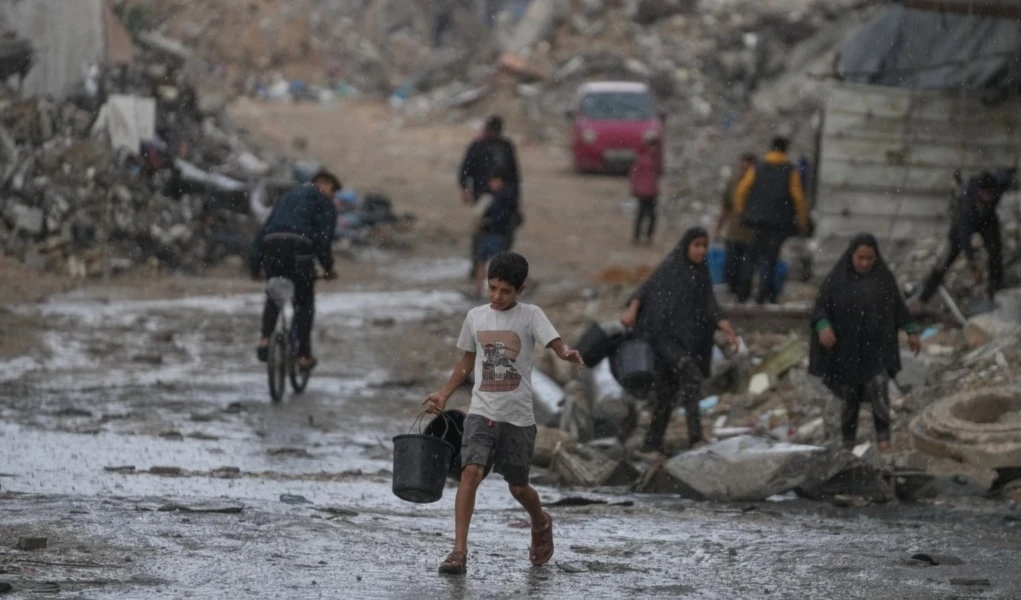Israeli troops say Gaza border razed to create fatal ‘kill zone’
Since resuming its war against Hamas, "Israel" has gained control of over 50% of Gaza, including a large buffer zone where homes and farmlands have been razed.
-

An Israeli army vehicle moves in the Gaza Strip as seen from southern occupied Palestine, Jan. 16, 2025 (AP)
"Israel" has dramatically expanded the buffer zone in the Gaza Strip since relaunching its aggression on the Gaza strip last month. According to the Associated Press (AP), it now controls more than 50% of the territory.
The IOF have razed Palestinian homes, farmlands, and infrastructure to the point of uninhabitability, according to rights groups. "Israel" currently holds an illegal buffer zone in Syria, Lebanon, and Palestine, furthering its plots of regional domination in the Levant.
Prime Minister Benjamin Netanyahu said last week that even after Hamas is defeated, "Israel" will maintain security control in Gaza and force Palestinians to leave. This is in conjunction with Netanyahu's visit to the White House today.
Scale of destruction
Hundreds of thousands of Palestinians used to live in the land that now makes up "Israel’s" buffer zone, an area that was key to Gaza’s agricultural output.
Satellite images show once-dense neighborhoods turned to rubble, as well as nearly a dozen new Israeli army outposts since the ceasefire ended.
The five soldiers who spoke to AP said Israeli troops were ordered to destroy farmland, irrigation pipes, crops, and trees. Similar crimes were committed in Lebanon, with video footage showing Israeli occupation forces (IOF) uprooting ancient olive trees from South Lebanon and moving them into the occupied territories during the 60-day ceasefire.
Israeli troops were also ordered to destroy thousands of buildings, including residential and public structures, under the pretext of leaving the Resistance fighters nowhere to hide.
Several soldiers said their units demolished more buildings than they could count, including large industrial complexes. A soda factory was leveled, leaving shards of glass and solar panels strewn on the ground.
According to AP, a soldier with the tank squad said that an armored bulldozer flattened land, creating a “kill zone”, and that anyone who came within 500 meters of the tanks, including women and children, would be shot.
“I came there because they kill us and now we’re going to kill them. And I found out that we’re not only killing them. We’re killing them, we’re killing their wives, their children, their cats, their dogs, and we destroyed their houses,” he said.
Expanding the buffer zone
The systematic expansion of the buffer zone has been going on since the war began 18 months ago, five Israeli soldiers told AP.
This buffer zone, initially about 1 kilometer deep, involved the demolition of homes and infrastructure, making the area uninhabitable for Palestinians. Israeli occupation forces demolished approximately 1,100 buildings near the Gaza-"Israel" border to create this zone, according to a 2024 report by Israeli N12 broadcaster.
When "Israel" resumed the war last month, it doubled the size of the buffer zone to as far as 3 kilometers (1.8 miles), according to a map issued by the military.
The buffer zone and the Netzarim Corridor make up at least 50% of the strip, said Yaakov Garb, a professor of environmental studies at Ben Gurion University. Last week, Netanyahu said "Israel" intends to create another corridor that slices across southern Gaza, the Morag Corridor.
The Gaza Strip is approximately 40 kilometers long and between 5 and 12 kilometers wide, with a population of 2.3 million people.
-

Source: Buffer zone perimeters by Garb, Yaakov, 2025, Harvard Dataverse Geospatial dataset (via AP)
Long-term militray strategy
It is unclear how long "Israel" intends to hold the buffer zone, although its ministers have not been shy to express their desire to build settlements in the Gaza strip.
As early as December 2023, Israeli Minister for Diaspora Affairs and Combating Antisemitism, Amichai Chikli, stated he doesn’t rule out Israeli settlements being established in the Gaza Strip "in certain parts where it makes sense." On that note, he urged "thinking out of the box" regarding potential solutions, suggesting, for example, that "Rafah can be under Egyptian control and Khan Younis under Emirati control."
Netanyahu said "Israel" aims to pressure Hamas to release the remaining 59 captives. He also said the war can only end when Hamas is destroyed and its leaders leave Gaza, at which point "Israel" would take control of security in the territory.
Then, Netanyahu said that "Israel" would implement US President Donald Trump’s call to force Palestinians out of Gaza under the title of “voluntary emigration".
"Israel" continues to illegally occupy five points within the Lebanese territories, with Israeli tanks advancing into border villages every now and again.
Ethnic cleansing, the ultimate objective
Last February, the Israeli Security Ministry announced its plan to establish a directorate for the forced displacement of Palestinians from Gaza under the name "Voluntary emigration from Gaza." This plan is tantamount to ethnic cleansing, defined under international law as the systematic removal of a group through force or coercion. Specifically, Article 7 of the Rome Statute refers to ethnic cleansing as part of crimes against humanity under Article 7(1)(d): "Deportation or forcible transfer of population."
Nadia Hardman, a researcher at Human Rights Watch, says that within Gaza’s buffer zones, specifically, it amounts to “ethnic cleansing”, because it was clear people would never be allowed to return.
Meanwhile, Israeli analysts claim that the purpose of the buffer zone isn’t to occupy Gaza but to secure it until Hamas is dismantled.

 5 Min Read
5 Min Read









